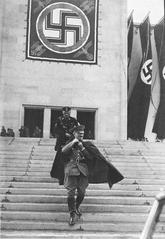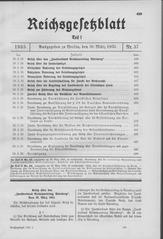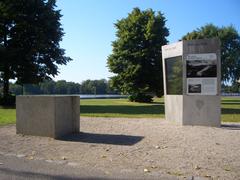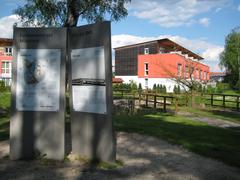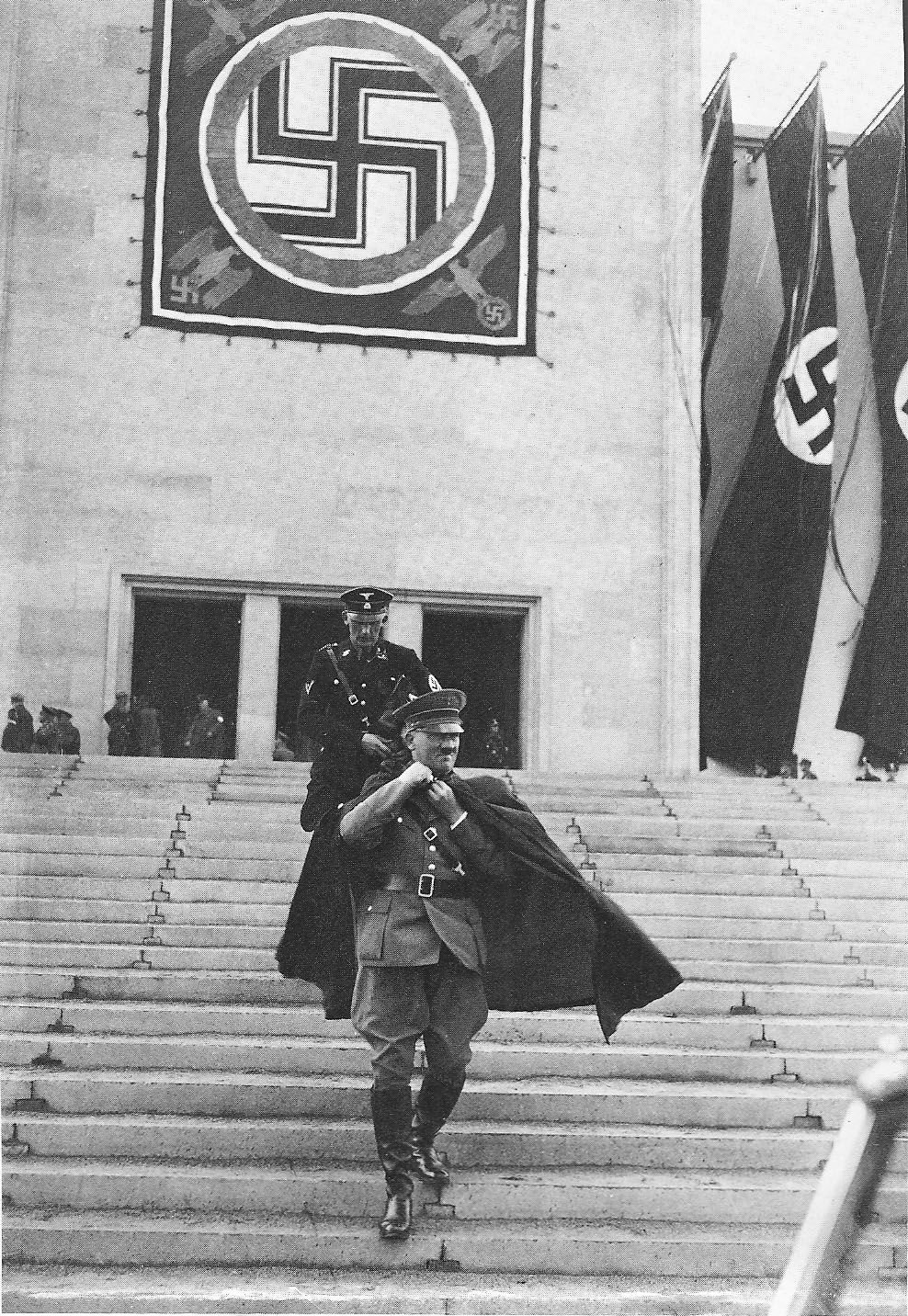
Visiting the Documentation Center Nazi Party Rally Grounds, Nuremberg: Tickets, Hours, and Tips
Date: 15/06/2025
Introduction
The Documentation Center Nazi Party Rally Grounds in Nuremberg is a site of immense historical significance, serving as a critical reminder of the rise and impact of National Socialism in Germany. Housed in the unfinished north wing of the monumental Congress Hall, the center confronts the legacy of Nazi propaganda, mass rallies, and architectural megalomania. Through its exhibitions and educational programs, it fosters reflection on totalitarianism, the importance of democratic values, and the ongoing relevance of remembrance culture.
This comprehensive guide provides essential details for visitors—covering practical information on tickets, opening hours, accessibility, and transportation—while offering historical and ethical context to ensure a respectful and meaningful visit. For the latest details, always refer to the official Documentation Center website and the Nuremberg tourism portal.
Table of Contents
- Introduction
- Historical Context and Significance
- The Congress Hall and Documentation Center: Architecture and Symbolism
- Planning Your Visit
- Exhibitions and Educational Offerings
- Key Sites at the Nazi Party Rally Grounds
- Visitor Guidelines and Responsible Tourism
- Cultural and Ethical Considerations
- Frequently Asked Questions (FAQ)
- Conclusion and Next Steps
- References and Further Reading
Historical Context and Significance
Nuremberg’s Role in Nazi Germany
From 1933 to 1938, Nuremberg hosted the annual Nazi Party rallies—massive propaganda events designed to demonstrate the regime’s unity and power. The rally grounds, spanning about 11 square kilometers, included monumental structures like the Zeppelin Field, the Große Straße (Great Road), and the Congress Hall. These spaces were engineered to awe, intimidate, and mobilize the German population for the Nazi cause.
Memory Culture and the Aftermath
After World War II, the rally grounds became symbols of a dark past. Rather than destroy them, the city of Nuremberg chose to preserve the site as a “Mahnmal” (warning monument), culminating in the establishment of the Documentation Center in 2001. The center’s mission is education, not glorification—encouraging visitors to engage critically with history and the dangers of totalitarianism (official Documentation Center website).
The Congress Hall and Documentation Center: Architecture and Symbolism
Congress Hall
The Congress Hall, designed by Ludwig and Franz Ruff, was intended to seat 50,000 people—twice the capacity of the Roman Colosseum. Though never completed, its imposing shell remains a stark reminder of Nazi ambitions (travel4history.com).
Documentation Center
In the 1990s, architect Günther Domenig transformed part of the Congress Hall into the Documentation Center. His design, featuring a dramatic steel and glass “stake” piercing the original building, powerfully symbolizes a break with the past. The exhibitions inside critically examine the mechanisms of National Socialism and the role of Nuremberg in Nazi history (traveladdicts.net).
Planning Your Visit
Tickets and Visiting Hours
- Opening Hours: Tuesday–Sunday, 10:00 AM–6:00 PM; closed Mondays and public holidays. Hours may change seasonally—always check the official website before visiting.
- Tickets: General admission is typically €7.50 for adults, €2.50 for reduced categories, €8 for families, and free with the NÜRNBERG CARD. Children under 18 often enter free; discounts apply for students, seniors, and groups. Some exhibitions and guided tours may require separate tickets (tourismus.nuernberg.de).
Getting There
- By Public Transport: Tram lines 6 or 8 to “Dokumentationszentrum Reichsparteitagsgelände”; S-Bahn to Nürnberg-Dutzendteich station.
- By Car: Limited parking near the Documentation Center; public transport is recommended during busy periods.
Accessibility
- The center is fully wheelchair accessible, including elevators and ramps. Assistance is available upon request—contact staff in advance for specific needs.
- Most outdoor areas are accessible, although some locations (like the Zeppelin Tribune stands) have limited access due to stairs.
Guided Tours and Educational Programs
- Guided Tours: Available in German and English; book in advance for groups or special topics. Tours provide expert commentary and may grant access to otherwise restricted areas (guided tours info).
- Educational Programs: Workshops, seminars, and digital learning opportunities are offered for groups of all ages (educational services).
- Audio Guides: Available in multiple languages; recommended for groups.
Nearby Attractions
- Nuremberg Castle
- Nuremberg Trials Memorial
- Old Town and Germanisches Nationalmuseum
- Silbersee Lake and Luitpoldhain Park
For a full cultural experience, combine your visit to the Documentation Center with these sites.
Exhibitions and Educational Offerings
Exhibition Highlights
- Interim Exhibition (2021–2026): “Nuremberg – Site of the Nazi Party Rallies. Staging, Experience and Violence” presents a focused overview of the rallies and their aftermath through multimedia installations, personal testimonies, and thematic displays (Documentation Center).
- Permanent Exhibition (from 2026): The new exhibition will broaden the perspective, framing the rally grounds within national and international contexts and emphasizing the concept of “dictatorship of consent” (tourismus.nuernberg.de).
- Virtual Tours and Media: Online resources and virtual tours are available for remote visitors (Documentation Center virtual tours).
Educational Mission
The center’s exhibitions use original artifacts, multimedia, and personal stories to foster critical engagement with the history of National Socialism, the mechanisms of propaganda, and the enduring importance of democracy.
Key Sites at the Nazi Party Rally Grounds
- Congress Hall: Largest preserved Nazi-era building; striking example of monumental propaganda architecture.
- Zeppelin Field and Zeppelin Tribune: Main parade ground for Nazi rallies, partially accessible. The Golden Hall beneath the Tribune is closed for renovations as of April 2024 (Nuremberg tourism portal).
- Große Straße (Great Road): 2-kilometer granite-paved parade axis, open to pedestrians and cyclists.
- Luitpoldhain and Luitpold Arena: Once a mass rally site, now tranquil parkland.
- Silbersee (Silver Lake): A peaceful lake created from a former gravel pit.
- Additional Sites: 23 marked locations, including remnants of barracks and the FC Nürnberg stadium, with informational panels for context (travel4history.com).
Visitor Guidelines and Responsible Tourism
- Respectful Conduct: Maintain a solemn and respectful demeanor. Avoid frivolous behavior or insensitive photography, especially selfies at memorials (Google Arts & Culture).
- Photography: Allowed outdoors; restrictions apply indoors. Drones, tripods, and commercial photography require permission.
- Dress Appropriately: Wear comfortable, weather-appropriate clothing and sturdy shoes.
- Plan Time Wisely: Allocate at least 2–3 hours to explore, or more for an in-depth visit.
Cultural and Ethical Considerations
The Documentation Center and rally grounds are not typical tourist attractions but spaces of remembrance and education. Their preservation is not an endorsement but a conscious choice to confront a difficult past. Visitors are encouraged to:
- Engage thoughtfully with exhibitions and guided tours.
- Recognize the ongoing debates around “difficult heritage” and the complexities of preservation versus erasure (Academia.edu).
- Prepare children and young visitors for the site’s sensitive content, using age-appropriate educational materials.
- Participate in events and discussions to deepen understanding of the lessons of National Socialism and the importance of democracy.
Frequently Asked Questions (FAQ)
Q: What are the Documentation Center’s opening hours?
A: Tuesday–Sunday, 10:00 AM–6:00 PM; closed Mondays and some holidays. Check the official website for updates.
Q: How do I purchase tickets?
A: Tickets are available on-site and online. Discounts apply for students, families, and groups. The NÜRNBERG CARD grants free admission (tourismus.nuernberg.de).
Q: Are guided tours available?
A: Yes, in English and German. Advance booking is recommended, especially for groups or special exhibitions.
Q: Is the site accessible for visitors with disabilities?
A: Most areas are wheelchair accessible, with assistance available upon request.
Q: Can I take photos?
A: Photography is allowed outdoors; observe restrictions indoors and be respectful in all areas.
Conclusion and Next Steps
Visiting the Documentation Center Nazi Party Rally Grounds is a powerful educational experience and an opportunity to engage with one of the most critical chapters in modern history. By preparing for your visit, respecting the site’s solemnity, and taking advantage of educational resources, you contribute to the ongoing mission of remembrance and the defense of democratic values.
For the latest updates on hours, ticketing, and exhibitions, always consult the official Documentation Center website and the Nuremberg tourism portal. Enhance your visit with the Audiala app for audio guides, and follow the center on social media for news and educational resources.
References and Further Reading
- Visiting the Nazi Party Rally Grounds in Nuremberg: History, Tickets, and Visitor Information, 2024
- Visiting the Documentation Center Nazi Party Rally Grounds in Nuremberg: Hours, Tickets, Exhibitions, and Educational Programs, 2024
- Nazi Party Rally Grounds Visiting Hours, Tickets, and Key Sites in Nuremberg, 2024
- Visiting the Documentation Center Nazi Party Rally Grounds in Nuremberg: Hours, Tickets & Ethical Guidelines, 2024
